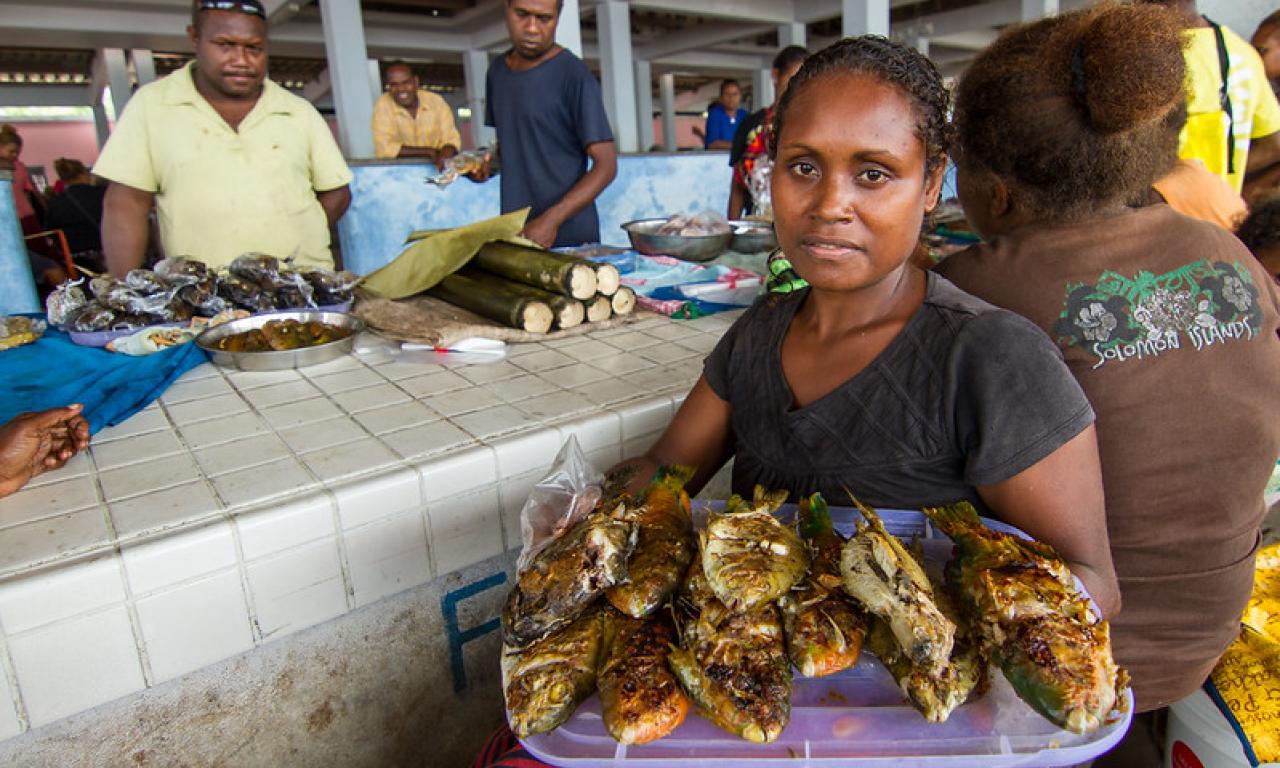
Globally, food production is exceeding sustainable limits while also failing to provide healthy diets for the world’s growing population, which will reach 9.8 billion people by 2050.
That was the finding of the recent EAT-Lancet Commission on Food, Planet and Health report, which calls for a radical and urgent transformation of the way we produce food.
Fish—a nutrient-rich, affordable, highly traded food produced with a relatively low carbon footprint—has a critical place in this transformation, explains Dr. Kendra Byrd, a nutrition scientist at WorldFish.
“By preserving capture fisheries and investing in sustainable forms of aquaculture—from catch to consumption—low- and middle-income countries can improve their nutrition and food security, which is at the heart of many public health issues,” she said.
“Fish and other aquatic foods from inland waters and marine systems will be key to addressing food and nutrition security in the face of climate change.”
While people often think of fish as a good source of protein, its real value lies in its potential to address micronutrient deficiencies, which account for an estimated one million premature deaths annually and reductions in national GDP of up to 11 percent.
“Fish is a rich source of bioavailable micronutrients, meaning our bodies can easily absorb and use them, and that they are only needed in small quantities,” Byrd said.
“These micronutrients are essential to human health and development, particularly in the first 1000 days of life from conception to two years of age.”
Different species, different nutrients
For the first time, a recent study by Lancaster University, WorldFish and partners has compared the nutrient content of marine finfish, finding that they vary significantly.
“For instance, marine fish in tropical waters are higher in calcium, iron and zinc, compared with those in cold regions, which are higher in omega-3 fatty acids,” said co-author Dr. Philippa Cohen, program leader, small-scale fisheries, WorldFish.
The research shows that in several countries, the nutrients available in fish catches exceed the dietary needs of coastal populations (within 100 km) which suffer from inadequate nutrient intakes.
“Researchers working in Africa and Asia have found that local fish species have high concentrations of iron and zinc—essential micronutrients that are missing from local diets,” she said.
“Redirecting a fraction of current landings to poor and vulnerable populations could be greatly beneficial for health and well-being—a single portion [100 g] of the average fish could provide half the daily recommended dietary allowance of iron and zinc for a child under four years.”

These significant findings underscore the need to ensure access to fish for local populations, even in regions where national averages suggest high levels of fish consumption, like the Pacific.
“Pacific countries have some of the highest rates of annual fish consumption, but consumption remains low in certain places and among certain vulnerable groups of people living in Vanuatu and Solomon Islands,” said Jillian Tutuo Wate, research fellow, WorldFish.
This has major consequences for individuals and societal health. A recent WorldFish study into malnutrition in rural Solomon Islands reinforced the findings of a national study showing that around 30 per cent of children aged under five years are stunted and micronutrient deficiencies persist in women of childbearing age.
Wate said the inclusion of fish in local diets in Pacific countries is influenced by factors such as availability, accessibility, preferences and cultural beliefs and practices.
“These significantly influence the diversity of household diets and the nutrition status of women and young children.”
Combating this will require a range of interventions, said Wate.
“There are opportunities to encourage healthy eating including the inclusion of fish, especially in the first 1000 days, as shown by the Albert et al. study,” she said.
“We must also raise awareness about food preparation and feeding practices, especially for children under two years of age. It is important to target both women and men to encourage both parents to share the responsibilities and support healthy eating for young children.
“Together with our partners, including the Ministry of Health and Ministry of Fisheries (both at national and provincial levels), WorldFish currently deliver nutrition information linked to community-based management of coastal fisheries. This supports the conversation between marine resource management and human health.”
Harnessing the power of fish

Increasingly, global efforts to improve food and nutrition security are focusing on understanding and working with complex food systems.
As defined by the High Level Panel of Experts on Food Security and Nutrition in 2017, “A food system gathers all the elements (environment, people, inputs, processes, infrastructures, institutions, etc.) and activities that relate to the production, processing, distribution, preparation and consumption of food, and the outputs of these activities, including socio-economic and environmental outcomes.”
Yet, a recent review of the literature found that research examining fish in food systems has not kept pace with this broadening framing.
“Fish remain largely invisible in food systems thinking, and only a fraction of research looked at multiple relationships and feedbacks of food systems, with most focusing on production,” said Dr. Fiona Armstrong Simmance, fish in food system scientist, WorldFish.
“Research, explanatory power, and the design of interventions around fisheries are yet to fully align within the food systems framework.”
Critically, the resilience of fisheries and aquaculture depends on several large-scale dynamics and drivers—trade, land use, water resource management, ocean futures, environmental change, food policies and regulations governing food production.
Further research into these factors, along with impactful partnerships, are key to transforming the role of fish to achieve food and nutrition security, said Simmance.
“Food systems research must better account for the unique nutritional attributes and low environmental footprint of fish, and methodological advances are needed to assess complex relationships between food sectors across scale.”
“By doing so, we can more fully examine and understand food and nutrition outcomes and the entry points to enhance them—with fish also playing a key role to improve the sustainability of the environment in the future.”